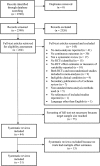Investigation of bias in meta-analyses due to selective inclusion of trial effect estimates: empirical study
- PMID: 27121706
- PMCID: PMC4853995
- DOI: 10.1136/bmjopen-2016-011863
Investigation of bias in meta-analyses due to selective inclusion of trial effect estimates: empirical study
Abstract
Objective: To explore whether systematic reviewers selectively include trial effect estimates in meta-analyses when multiple are available, and what impact this may have on meta-analytic effects.
Design: Cross-sectional study.
Data sources: We randomly selected systematic reviews of interventions from 2 clinical specialties published between January 2010 and 2012. The first presented meta-analysis of a continuous outcome in each review was selected (index meta-analysis), and all trial effect estimates that were eligible for inclusion in the meta-analysis (eg, from multiple scales or time points) were extracted from trial reports.
Analysis: We calculated a statistic (the Potential Bias Index (PBI)) to quantify and test for evidence of selective inclusion. The PBI ranges from 0 to 1; values above or below 0.5 are suggestive of selective inclusion of effect estimates more or less favourable to the intervention, respectively. The impact of any potential selective inclusion was investigated by comparing the index meta-analytic standardised mean difference (SMD) to the median of a randomly constructed distribution of meta-analytic SMDs (representing the meta-analytic SMD expected when there is no selective inclusion).
Results: 31 reviews (250 trials) were included. The estimated PBI was 0.57 (95% CI 0.50 to 0.63), suggesting that trial effect estimates that were more favourable to the intervention were included in meta-analyses slightly more often than expected under a process consistent with random selection; however, the 95% CI included the null hypothesis of no selective inclusion. Any potential selective inclusion did not have an important impact on the meta-analytic effects.
Conclusion: There was no clear evidence that selective inclusion of trial effect estimates occurred in this sample of meta-analyses. Further research on selective inclusion in other clinical specialties is needed. To enable readers to assess the risk of selective inclusion bias, we recommend that systematic reviewers report the methods used to select effect estimates to include in meta-analyses.
Keywords: Bias; Randomised trials; STATISTICS & RESEARCH METHODS; Systematic reviews.
Published by the BMJ Publishing Group Limited. For permission to use (where not already granted under a licence) please go to http://www.bmj.com/company/products-services/rights-and-licensing/
Figures



References
Publication types
MeSH terms
LinkOut - more resources
Full Text Sources
Other Literature Sources
